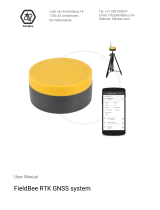Novatel GM-14915095 is a high-performance GNSS receiver card that provides accurate positioning and navigation data. It is ideal for use in a wide range of applications, including surveying, mapping, and navigation. The GM-14915095 supports all major GNSS constellations, including GPS, GLONASS, BeiDou, and Galileo. It also supports a variety of correction services, such as SBAS, L-Band, and RTK, which can improve position accuracy to centimeter level. The GM-14915095 is a versatile and powerful GNSS receiver card that is well-suited for a variety of applications.
Novatel GM-14915095 is a high-performance GNSS receiver card that provides accurate positioning and navigation data. It is ideal for use in a wide range of applications, including surveying, mapping, and navigation. The GM-14915095 supports all major GNSS constellations, including GPS, GLONASS, BeiDou, and Galileo. It also supports a variety of correction services, such as SBAS, L-Band, and RTK, which can improve position accuracy to centimeter level. The GM-14915095 is a versatile and powerful GNSS receiver card that is well-suited for a variety of applications.












-
 1
1
-
 2
2
-
 3
3
-
 4
4
-
 5
5
-
 6
6
-
 7
7
-
 8
8
-
 9
9
-
 10
10
-
 11
11
-
 12
12
Novatel GM-14915095 User manual
- Type
- User manual
- This manual is also suitable for
Novatel GM-14915095 is a high-performance GNSS receiver card that provides accurate positioning and navigation data. It is ideal for use in a wide range of applications, including surveying, mapping, and navigation. The GM-14915095 supports all major GNSS constellations, including GPS, GLONASS, BeiDou, and Galileo. It also supports a variety of correction services, such as SBAS, L-Band, and RTK, which can improve position accuracy to centimeter level. The GM-14915095 is a versatile and powerful GNSS receiver card that is well-suited for a variety of applications.
Ask a question and I''ll find the answer in the document
Finding information in a document is now easier with AI
Related papers
-
Novatel SPAN® on OEM6 User manual
-
Novatel OEM6® User guide
-
Novatel SMART6 User manual
-
Novatel OEM617D User manual
-
Novatel DL Base Station User guide
-
Novatel SMART ANTENNA User manual
-
Novatel RTKNav/RtStatic Version 3.15 User manual
-
Novatel GM-14915118 User manual
-
Novatel NovAtel Connect User guide
-
Novatel SPAN® on OEM6 Quick start guide
Other documents
-
Land Rover 2002 Range Rover User manual
-
 QF RTK GNSS Base RTCM32 Station User guide
QF RTK GNSS Base RTCM32 Station User guide
-
 FieldBee RTK User manual
FieldBee RTK User manual
-
mettatec X5 User manual
-
AvMap All in One RTK User manual
-
Brookstone Rover Land & Sea User manual
-
 TERSUS BX316R User manual
TERSUS BX316R User manual
-
 Forsberg MICROpod Series User manual
Forsberg MICROpod Series User manual
-
EOS Server User guide
-
Brookstone ROVER Land&Sea User manual















